Пост взят с WatchPro, привожу как есть... Думаю, будет интересно...
Kari Voutilainen Vingt-8
Gentlemen,
As I promised when I posted my first pictures, here is the review of my Kari Voutilainen "Vingt-8".
INTRODUCTION
As you know, I love the independent watchmaking world. Their watches are unique in design, style and their company's structure and flexibility is also very different from traditional brands. Their independence allows original technical and aesthetical orientations because their goal is not to please the largest market share possible but because their pleasure is to introduce more daring objects they often dreamt of creating in their past career.
They can simply decide to go further in one way instead of balancing all the areas.
Aside from what we see, there is what we feel and the personality of the watchmaker; its role is something quite essential in the choice of a brand or another. These aspects usually don't leave room for apathetic feelings: you like them or you don't.
The interesting part is that you can find a kind of personalized choice depending on what you're looking for.
This brings me back to what I was looking for.
WHAT I WAS LOOKING FOR
I like perfection and you already know I pay a very close attention to a perfect finishing as it represents for me the highest degree of talent in the handcrafting work. It is highly time-consuming work and requires years of practice to master. It is hence rare.
The more you dive into finishing perfection, the fewer people can perform the work, as the skill requires more and more experience and talent.
Aesthetic choices are personal but I like daring style; I like what is elegant and what will not go out of fashion too soon (one of the meanings of the word "classical"). Whatever side I choose, it mustn't be boring and neutral.
I don't like putting someone on a pedestal or behaving like a dumbstuck fan. Nevertheless, based past experience, I've been closely looking at Kari Voutilainen's work. Currently his watches really speak to me in the ways explained above, to say the least.
He must be one of the most talented watchmakers today and he shows his will to move on every time he can, aiming at better accuracy, better efficiency and better reliability.
This being said, let's talk about the watch.
A BIT OF HISTORY
Its predecessor, the Observatoire (3 hands 38mm watch, manual wound, awarded Geneva Grand Prix d'Horlogerie in 2007), was the first regular wristwatch KV has launched from an existing limited batch of Peseux 260 ebauche. At this time he created a watch style that we recognize him for up to today: teardrop lugs, unique classic and gorgeous case shape, "big apples" hands, dial design DNA, applied numbers' shape etc...
This first step allowed him to move on with his own in-house caliber in 2011. Previously, having the plates or bridges outsourced was troublesome because of high delivery time and inertia when dealing with handmade and personalization work. He could not perfectly control any of the cost, delivery time or quality issues. He wanted something reliable and able to be serviced by any professional watchmaker in the future.
He also would take into account future complications. Thus, there is no "exotic" component or coating technique either (silicon, diamond reinforcement etc...).
After several tests and as he wanted something accurate and energy efficient, he came to the conclusion he should choose a double wheel with direct impulse escapement (a kind of natural escapement display) in order to gain up from 30% to 40% more power compared to a traditional Swiss lever one.
The figures are difficult to verify of course but anyone who has met him and has been following his work know he always tries to use the wide experience he gathered in his carrier to improve timekeeping.
(As an aside, during the last Belles Montres 2014 in Paris, he showed me a Tourbillon version equipped with an unusual metal that he was testing to see if it brings such improvement or not. That's his philosophy and, I guess, a part of his pleasure in the pursuit of perfection as a watchmaker.)
The sketch of the in-house caliber 28 was born and designing it from top to bottom is truly a great achievement.
THE VINGT-HUIT ORIGIN
The Vingt-8 (Twenty-8) presented in 2011 is the watch following the Observatoire. The watch is his first one fully designed, built and finished in-house (except, if I recall correctly, the jewels, hairspring and barrel spring) and needed 3 years development, starting in 2008, hence the "Vingt-8" name (28 in French).
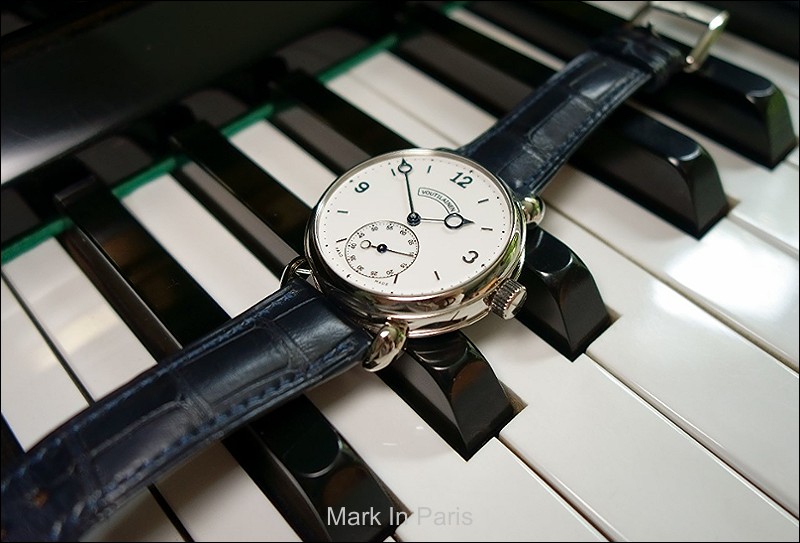
KV has conceived a movement which features two escape wheels which deliver a direct impulse to the balance wheel leading in less energy consumption and less wear and tear. This allows the impulse in two directions each time, on the contrary to a standard lever escapement.
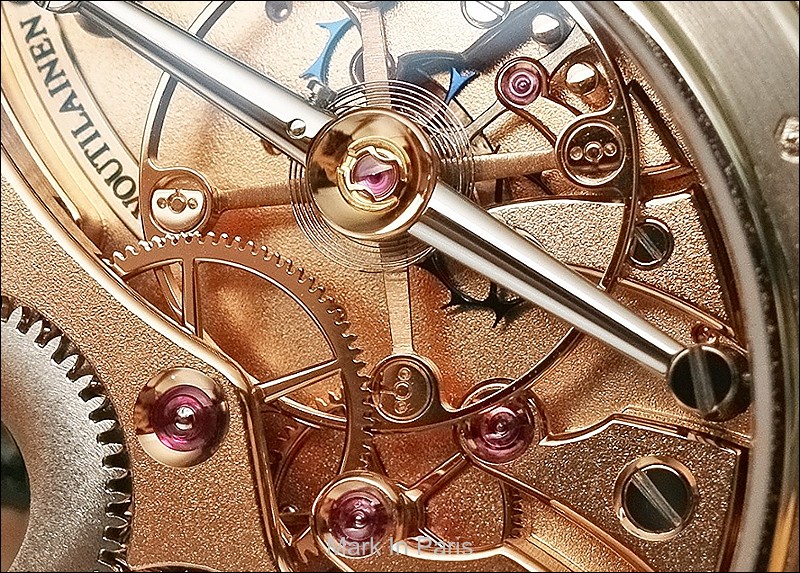
Another aim of the caliber's design was to avoid problems due to lubricant deterioration (related to the reliability issue) which has always been a main concern of watchmakers.
Furthermore, the hairspring is a mix of two worlds: a Grossman curve for the inner side (keeps the gravity balance point centered) and a Breguet (Philips) overcoil at the outer edge for the spiral, which "breathes" in a concentric motion (less pressure on the pivots), resulting in a better chronometric performance.
Some statistics: it's a 39 x 11.5 mm case size with a 65 hours power reserve and 18,000 vph movement.
THE CASE
The case is in white gold and fully polished in a wonderful way.
The classical case and lugs shape are not subject to fads, and remain discreet and wearable every day, on any occasion.

I thought about adding a "cabochon" in Onyx to the crown but decided finally to leave it simple and purer, in the same way as I chose the dial. I can still add one in the future: a blue sapphire that would match with the hands' blued parts could be very nice too...
THE DIAL
The dial was a long issue to cope with. KV has a lot of talent in making them. He is an expert in "guilloché" decorated dials but he also created the lacquered dials we could see for instance when he launched his V8-R line in 2013.
He acquired his own dial factory not long ago and I'm sure this mastery will then be reinforced.
The good thing with an independent watchmaker is that you can suggest some personalized details and the dial's decoration is of course the more important. I had to choose the one that spoke the most to me without drowning in the details at a point where I wouldn't be able to make a decision.
Of course, I knew that one of KV's manufacture talents is the mastery of working Guilloché dials with the original machines he has purchased in the past. Did I have to choose the Guilloché decoration I found sometimes nice but not a 100% to my taste? I have a hard drive full of examples I could study but wasn't fully satisfied with this possibility.
The other available option was to get a lacquered dial (it was my first one in fact). I couldn't see it in the flesh, but read quite many testimonies of the deepness and beauty of this finishing and I could see one great video of how it looked like. It happens to have exceeded all my expectations.
What makes the dial look so deep and beautiful is that the lacquer is applied in several layers and then polished. In fact the dial is in silver and shaped like a 0.20mm deep basin. This basin is filled with 0.02mm layers of lacquer which have to dry between each step. When the basin is fulfilled and dry, it is treated alternatively in a high temperature oven and at ambient temperature. After this process, it is very finely polished.
The result is fantastic and, as you can imagine, has to be seen to be appreciated.

From what I understand from Mr Voutilainen when he explained this work, it is more time consuming and there is not many people able to perform this polishing work on lacquers anymore.
The choice of a pure white (not grey nor creme) is exactly what I was looking for.
What then remains particularly difficult when dealing with such a dial is to make the holes for the central axle and for fastening the markers, numerals and nails without damaging the lacquer.
In the end, this dial is exactly what I wanted and I think it is better than enamel (aesthetically speaking).
A reason this dial color and technique was the right one was the way it matches with the white gold case and that it exudes a very appealing "snowy" and bright aspect
I knew I couldn't go wrong with either choice and I also knew I could order an additional one in the future if I wanted some change.
Thus, after a while I confidently choose the white lacquered dial.
I also decided to add a cartouche (frame) around the printed "Voutilainen". It balances the small second subdial at 6 o'clock. Without this cartouche, I would have felt that there is too much weight on the bottom of the dial and not enough on top.

The hands, very characteristic of Kari’s DNA, are made in white gold with blued steel parts and need 3 days work. The figures are applied numerals in white gold at 12, 3 and 9 and I chose to add simple "baton" markers for the other 5-minutes steps. The dial needs to be pierced to introduce the pins which are then fastened and this is a very delicate move as the polished dial can be damaged. Here again the result is of the highest precision.
I felt the Arabic numerals were fitting better than Roman numerals with such a dial. I love his Roman numerals without serif but it wouldn't do for me here. A completely subjective feeling of course.
A little detail I love is the small second hand's counterweight: the circle is thinner at the end side and looks like a "moon" that way. It is a very romantic touch IMHO.

Visually, the bezel flange is very thin and the hands are very close to the sapphire glass. The impression is very nice.
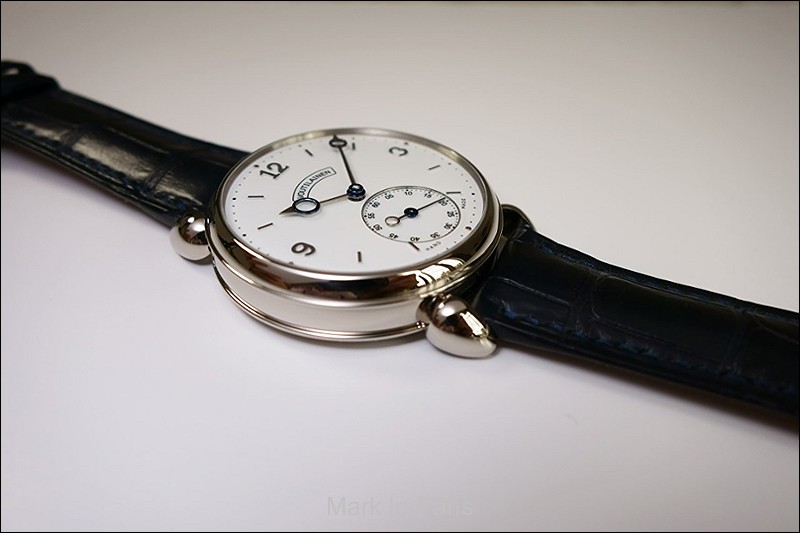
THE MOVEMENT

The movement is 30 x 5.6 mm. It is quite thick as it is made of 3 levels and is conceived to be able to receive additional complications and not being able to bend over time.
For this watch, I had to choose which decoration to pick.
It is not unusual to see the Côtes de Genève and I felt I wanted to have something different. Furthermore, with a white gold case I'm not keen on having a yellowish movement: it happens with aging Maillechort patina and with the white gold "frost" coating as well, which is a little more yellow than the case's colder color or the steel rochet and crown wheels for instance.
I really liked KV's movement frosted finish (made with a brush technique). I find it an appealing finishing from what I saw in some G&F, KV, Lang & Heyne or R. Smith watches for instance. Then, I had to choose which kind of coating color (Ruthenium grey, WG, RG, YG) and it was Rose gold straight away: warm and beautiful.
Another reason why I chose the frosted finishing is the legibility of the movement parts.
From the pictures shown below, you can see that the movement is composed of a beautifully shaped and polished main bridge and 5 small bridges underneath the balance wheel, nicely placed as "steps" going deeper into the movement's structure. When the Côtes de Genève is decorating the upper bridge, the lower plate is usually decorated with a "perlage" pattern. Though the latter is very nicely carried out by KV (very rare signs of scratches which are usually an inherent flaw of this kind of work), it shines quite a lot in every directions and you don't see clearly the details as the little individual bridges' shape or the two escapement wheels etc... With the frosted pattern you can visualize the different elements more clearly and admire them better. Each detail comes out.

The gear train is composed of rose gold wheels strengthened by a "laminage" process and of course the screws are mirror polished with beveled slots.
The beautiful central wheel (second wheel?) is laminated and hence made harder than brass for instance. it is then beveled and black polished over and under.

The gear train is composed of rose gold wheels strengthened by a "laminage" process and of course the screws are mirror polished with beveled slots.
The beautiful central wheel (second wheel?) is laminated and hence made harder than brass for instance. it is then beveled and black polished over and under.

The large free-sprung balance wheel, in stainless steel (13.6mm of diameter) to allow a very fine finishing, is not something you can miss when admiring the movement. The steel material is used for longevity purposes and for its inertia qualities compared to softer gold.
It is fun to hear the very low "tic-tac" noise from the movement as I realize that I was really used to hearing much faster beat.
Concerning the technical aspect of the escapement I talked about earlier, here is what Kari told Joseph Flores when he made his research about the two wheels escapement with direct impulse:
"...the two plates are separated and the impulse is hitting rubies directly which I find to be a better solution as we can position each plate in the optimal way, as well as the anchor which stops the wheel.
The positions of the plates and anchor prevent the escapement wheels from skipping a tooth in case of a shock.
The second wheel is "free" but I find it doesn't disturb the movement's functioning when adjustments are made in the right way. In a wristwatch, we have to keep a security margin in order to behave correctly when it is submitted to shocks (anti-shock absorber systems can move by several 1/100ths of a millimeter).
We have tested our movement and compared theoretical data to notice we can use a 30 to 40% weaker barrel spring."
This last element has of course an impact on the wear and reliability of the parts (and especially the pivots).

The efficiency is improved as the impulse acts in two directions each time. This requires more energy, hence the effort from KV to improve each part's design involved in the gear train in order to keep the energy consumption as low as possible.

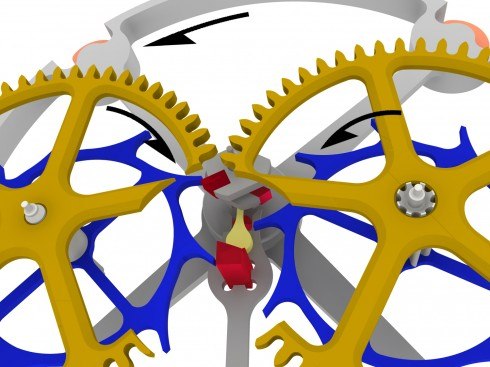

Oil aging is a significant issue when considering escapement regularity over time. The natural escapement was conceived by Breguet to try to solve a part of this problem. The oils move from parts to others and may disappear from the locations it is meant to protect from frictions. This phenomenon is very well explained in KV's book.
You can have an idea of KV's experience and dedication to create a caliber that would be as elaborated and as well engineered as possible.
By the way, you'll notice the two gears which transmit the movement to the gear train and hands are hidden on the other side of the plate, thus remaining invisible. Of course, we may think it is always nice to see the wheels KV has been finishing but this layout visually separates the escapement part from the rest of the movement and it is quite nice looking as it seems to work independently (magically?) from the rest.
Of course, in the end, the movement is very finely finished, like a very few watches on the market. Finishing is not just a question of look and shine, it also limits the proportion of irregularities and hence the wear and friction issues. It also limits the porosity and thus the corrosion of the pieces as time goes by. That's why hidden parts may also have to be finished.
Finally, the caliber is equipped with a Stop-second feature.

STRAP AND BUCKLE
The strap is equipped with retractable stems, much easier to manipulate than regular ones (hence less risky for the lugs finishing) as you don't need to squeeze the bracelet to have access to the stem.
The Ardillion buckle is really nice too, with the engraved Voutilainen name on the inside.

The charm that exudes through this watch is fantastic and shows an elegance I rarely have had the chance to handle in a watch.
THE BOX
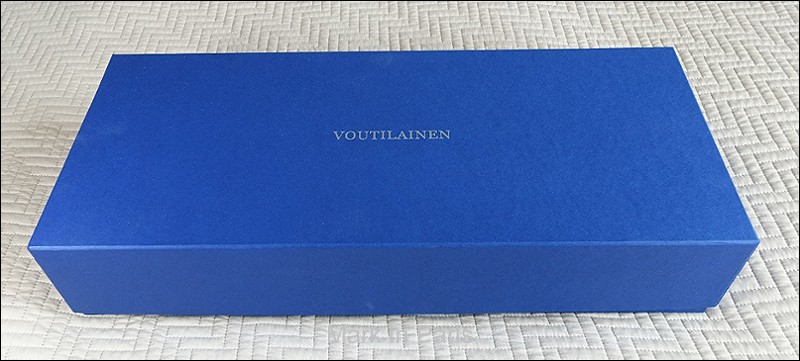
Well, even if they usually take room in our closets and that their cost is included in the overall price of the watch, I love watch boxes. This is a way to show fine craftsmanship in every detail and can be appealing to admire.
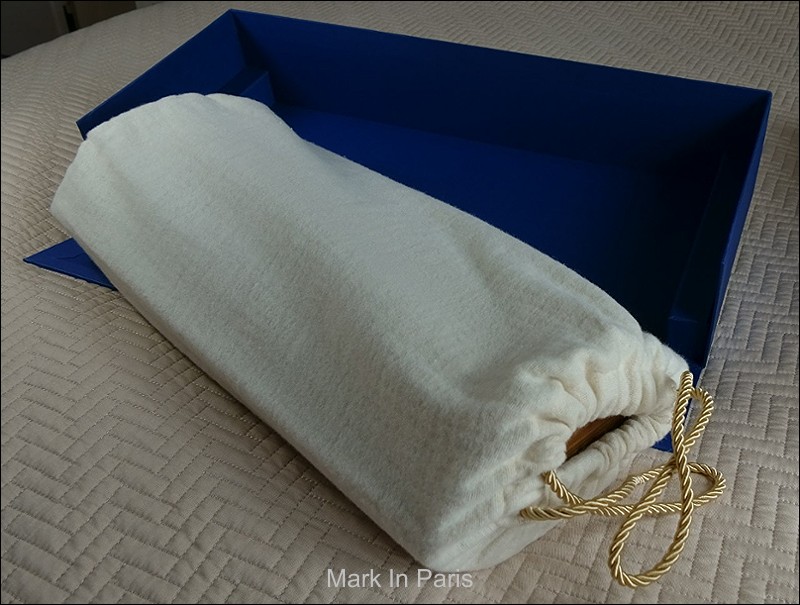
When I saw Patek's wooden box with their top-notch lacquered finish, I really said to myself this was certainly the best one out there, at least that I might know of.
However, the box used for KV's watches has reached another level. In fact, the box is crafted by a Swiss cabinetmaker: Vichard. It is a marvelous and nicely shaped wooden box (it reminds me of a plane wing), with a very nice marquetry work in the inner side of the top. The box's hinge and all the visible metallic parts (opening buttons and inside parts) are in brass and galvanized.

The mechanism which maintains the watch still is quite clever and well designed too.
When you lift the cover, there is room for the guarantee and usual papers. There is also a little booklet concerning the box and the Vichard manufacture.

It simply looks amazing and I think it will perfectly sit in my living room.\
While I was reading the usual booklets, I found funny to read that KV suggests winding the watch in the morning, but also in the evening, to maintain its accuracy. It seems of course logical as it will maintain the watch in the upper part of the efficiency curve and thus improve the watch's accuracy but I personally never thought about doing it before going to bed.

CONCLUSION
Beginning from the book about his carrier written by Theodore Diehl (texts, testimonies and especially photographs and colors' choices...) to the box (metallic, leather and marquetry work, booklets...) and of course to his watches, Kari Voutilainen reveals an exquisite and exemplary taste and skill.
To me, Kari Voutilainen's pieces are a perfect example of understated elegance with a high finishing standard all the way from the dial side to the movement, with a classic and romantic excellence.
We can easily feel the kind of experience needed and the relentless watchmaker's endeavor in making absolutely no compromise, from the first drafts to the final piece.
An exit watch? I don't think so, but a fundamental one for sure.
I hope you had as much pleasure in reading this review as I had in writing it, even if it is a "wee bit long". I thought that, as we don't talk about these very much, it could be enlightening and entertaining and could also open new doors for those who share my interest in independent watchmaking.
Cheers,
Mark


















 Похожие темы
Похожие темы